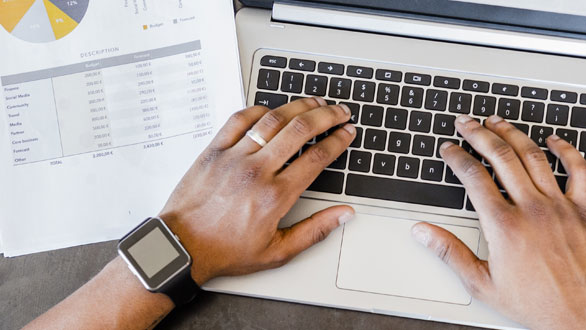Fraud protection.
Now it’s personal.
ANZ Falcon® technology monitors millions of transactions every day to help keep you safe from fraud.
Falcon® is a registered trademark of Fair Isaac Corporation.
Working from home has become the norm for many people, which means it’s never been more important to work securely and maintain visibility over where corporate and customer information is stored and shared.

Working from home can be a great time to build capability
Your leaders are no doubt concerned about protecting information and systems as you work remotely. Your staff might also feel more exposed to cyber threats when working outside the office environment.
Educate your team in cyber security practices, such as detecting scam messages and managing information to ensure security and privacy is maintained for both customers and your organisation.
It’s important to secure our workplace virtual valuables in the same way we do our physical ones.
One way to do this, is by making a P.A.C.T.
before sharing your personal information
Ask yourself, do I really need to give my information to this website or this person? If it doesn’t feel right, don’t share it.
Does your organisation have an information classification approach? Do staff understand what can be shared with whom and through what channels?
Talk about social media, collaboration tools etc. and decide what’s right for your organisation. Ensure staff protect and transfer information in safe ways.
Remember that USBs and other forms of “removable media” can be easily misplaced or corrupted with malware by inserting them into devices that aren’t secure. An option is to disable media reading or only allow media such as an encrypted USB supplied by your organisation.
two layers of security with multi-factor authentication
Use multi-factor authentication for an extra layer of security to keep your personal information safe.
Wherever possible turn on or look to implement multi-factor authentication for important tools like remote access systems and resources (including cloud services).This will provide an additional layer of security, and takes pressure off poor password management.
suspicious messages
Be aware of current scams. If an email, call or SMS seems unusual, check it through official contact points or report it.
Make sure staff know what to do if their device is lost or stolen or they experience a cyber or information security incident.
It’s important you can quickly respond to events and this is only possible if staff have an easy way of reporting concerns.
automatic software updates
Set your software, operating system and apps to auto update to make sure you get the latest security features.
Ensure your systems, including Virtual Private Networks and firewalls, are up to date with the most recent security patches. This will ensure your systems have the latest security software on them.
Apply a Virtual Private Network (VPN). VPNs allow remote users to securely access your organisation’s network, such as email and file services.
VPNs create an encrypted network connection that authenticates the user and/or device, and encrypts data in transit between the user and your services.
Ensure staff only use approved software and applications. Staff working from home may attempt to use different software to help them when away from the office environment.
It’s important to know where your information is stored and how it is shared to protect it from, and where necessary, enable a response to potential data loss or cyber compromise events.
Devices used for working outside an office environment are more vulnerable to theft and loss.
Ensure staff understand the risks of leaving their own or their organisation’s devices unattended, encourage them to keep devices somewhere safe and to lock them when they’re not being used to prevent unauthorised access.
For additional controls, review the Australian Government’s Signals Directorate Essential Eight. These represent strategies to mitigate cyber security incidents in a prioritised list to assist organisations in protecting their systems.
For more information and tips on how to be safe online, visit ANZ security hub.
Bringing our work practices of information handling and cyber security into our homes.
Stay on top of the latest online safety tips to help you keep yourself and your money secure.
Call out anything suspicious relating to your ANZ banking by reporting it to us.
Personal Banking Customers:
13 33 50 / +61 3 9683 8833
Business Customers using ANZ Transactive:
13 70 28 / +61 3 8693 7153
This information seeks to raise awareness and provides general information only. It may be necessary or appropriate to ensure that measures are taken in addition to, or in substitution for, the measures presented having regard to your particular personal or business circumstances.